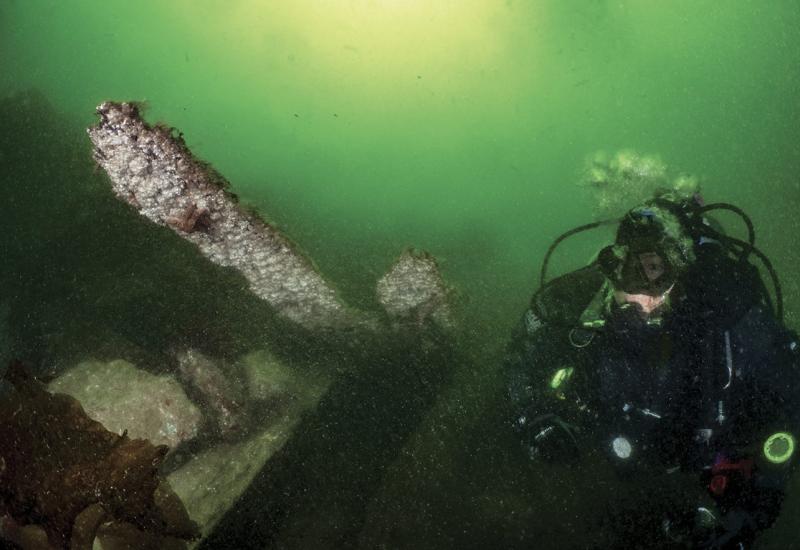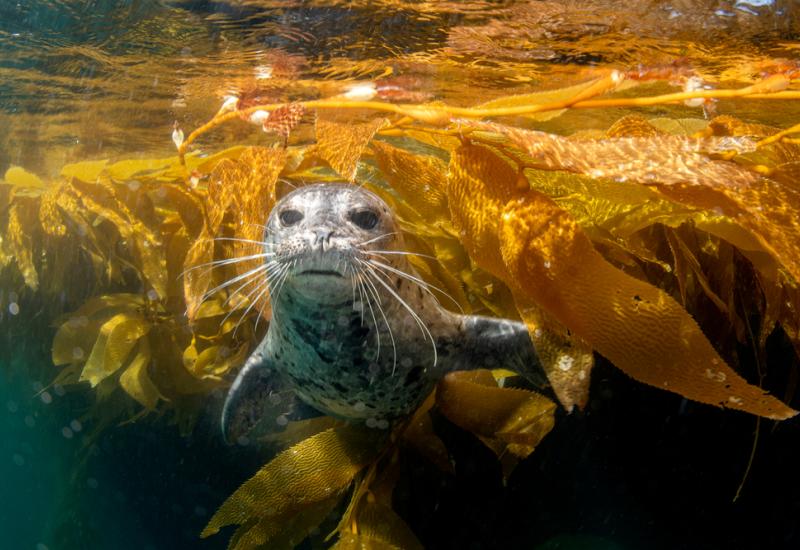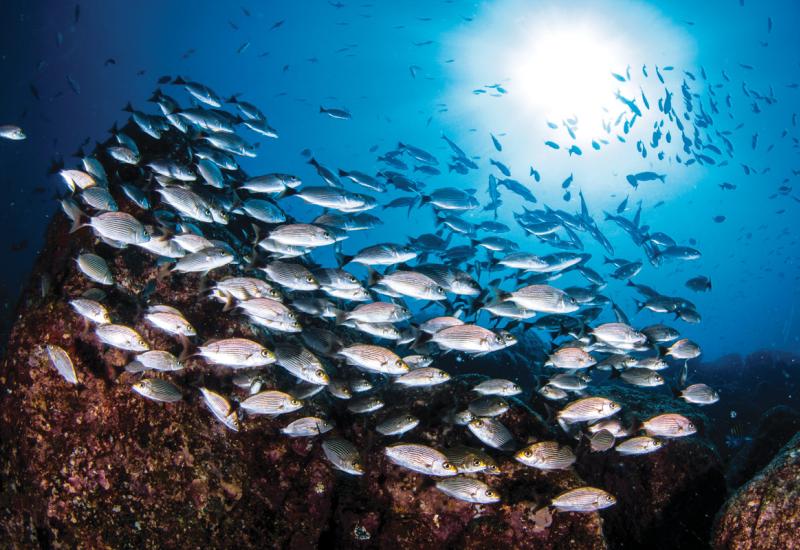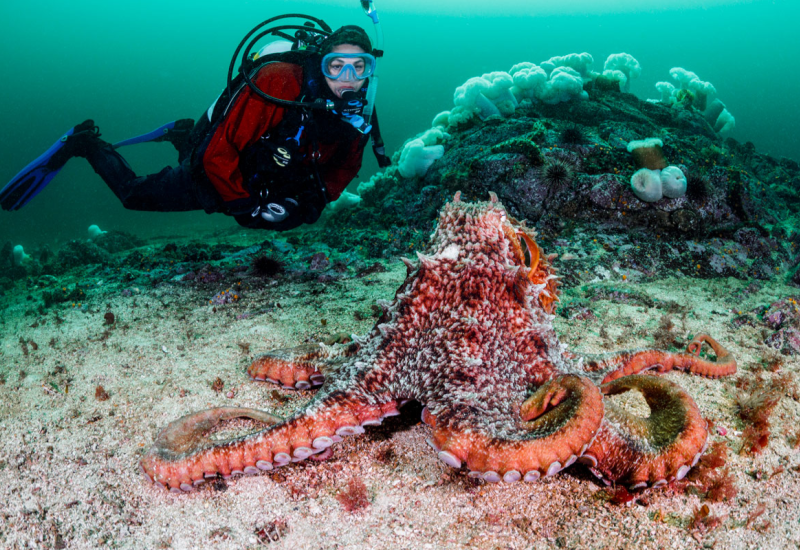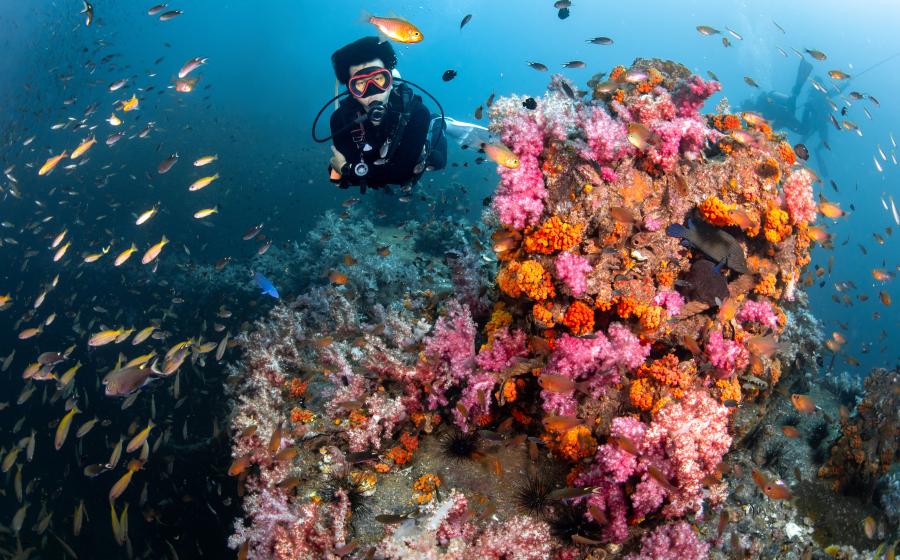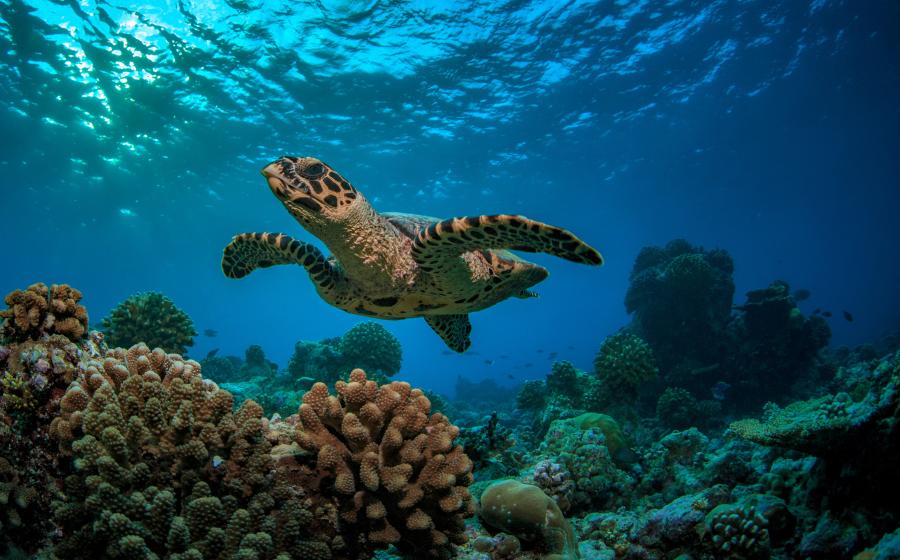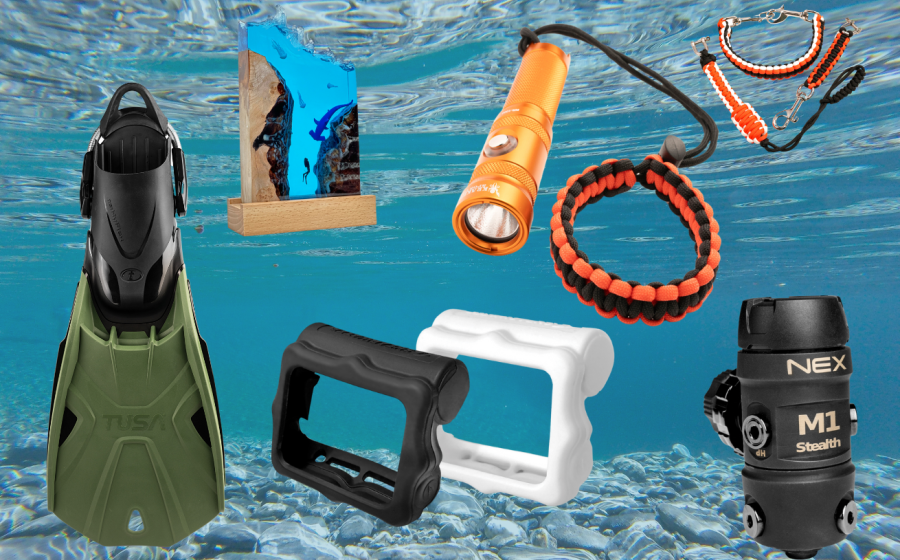Kingston, Ontario
March 2008
By Erica Blake
They look like ordinary, everyday tools--some wrenches, some files and a hand drill. But finding them nearly 100 feet below the surface of Lake Ontario on the Munson, a two-level dredge that sank in 1890--and one of the most visited shipwrecks in the Great Lakes--is thrilling.
The tools were abandoned by some of the crewmen rescued from the waves that engulfed this 250-foot barge as it was being towed back to shore. And items like these once belonged to the seamen who perished in these depths. But don't swim too close to the rickety workbench that holds the tools. Local dive boat captains warn that the bench has collapsed several times. And with each collapse, the Munson's history and the legacy of the men who toiled on its decks disintegrates just a little bit more.
With upward of 24 known moored wrecks, including schooners, barges and passenger ships, Kingston, Ontario, is a tempting destination for cold-water wreck divers. In fact, more than 400 ships are known to have wrecked in the area. Kingston, situated halfway between Toronto and Montreal at Lake Ontario's eastern end, is where many vessels exiting and entering its port succumbed to storms, crashes or just bad luck. In fact, the wrecks are so central to the city's tourism, both the provincial government and the organization Preserve Our Wrecks (P.O.W.) keep watch over the sunken vessels, protecting them from scavengers. With water temperatures ranging from the low 40s to mid-60s, visibility about 45 feet and clumps of razor-sharp quagga mussels often blurring the details of shipwrecks, diving in Kingston isn't for the faint-hearted. Still, like all good Great Lakes dive sites, the winning combination of diveable wrecks and challenging conditions offers an exciting underwater world to explore.
The George A. Marsh
The final moments of the sailors aboard a Great Lakes ship is most apparent on the 135-foot, three-masted schooner the George A. Marsh. Its crew--some of whom perished--left behind many artifacts when it foundered in a savage 1917 storm on its way back to its home port, Kingston. The Marsh, which was carrying coal on its final voyage, now rests 80 feet below the surface. A disintegrating leather boot and rusted-out teapot serve as sobering reminders of the 12 people on board that night who died in the storm, including the captain, his wife and five of their children.
The schooner is almost completely intact, giving divers a close view of its wheel, toppled mast and gearing. The long bowsprit with ropes hanging down from the sides can be found at the ship's bow.
The Comet
This ship's tragic history is memorialized in its nickname, the "hard-luck ship." The Comet, a 175-foot side-wheel steamer that shuttled passengers and package freight, sunk in 1851 after colliding with a schooner. Today, it rests upright in 90 feet and there are portions of the ship's rails to explore. But I found myself gravitating toward its most unique feature--its massive paddle wheels. Although I've splashed into each of the Great Lakes, this was the first vessel of its kind I'd ever seen entombed in these fresh, frosty waters. Today, many of the Comet's artifacts, including its wheel, can be found at Kingston's Marine Museum of the Great Lakes, which has galleries filled with hands-on exhibits that explore the stories of freshwater sailors.
The Wolfe Islander II
This is Kingston's only shipwreck whose history is void of heartache and tragedy.
The Wolfe Islander II's voyage to the bottom of Lake Ontario was the result of an intentional scuttling in 1985, about three miles from Kingston--the first such one in any of the Great Lakes. Here, divers can navigate the two completely intact levels of the 144-foot steel ferry, including its staircases and outside decks. It was sunk to a depth of 85 feet and despite the constant Great Lakes expectation that fish won't be seen, I saw a plethora of them, including large drums--or sheephead, as the boat captains said they're called in Canada--lazily swimming around the wreck.
But divers can't be as lax while exploring these waters.
Bring a dive light. The depth of a wreck and the possiblity of penetration may leave you in the dark. And if you get too curious and swim too close to a wreck's body, the razor-sharp edge of a mussel can slice your dry suit. Even a tiny one can cause a very cold leg--a lesson I learned the hard way.
But the most difficult part about wreck diving off Kingston isn't the chill, the darkness or the vis. It's choosing a favorite. One veteran diver who was asked what his favorite Great Lakes shipwreck is replied, "All of them."
Dive In: Kingston, Ontario
Location: Kingston, Ontario, Canada, is about halfway between Toronto and Montreal. It's about a seven-hour, 385-mile drive from Detroit, Mich., and about a four-hour, 30-minute, 275-mile drive from Buffalo, N.Y. From Toronto, Kingston is about a three-hour, 165-mile drive and is about two hours and 120 miles from Ottawa. If you're a U.S. citizen, don't forget your passport. For more information, visit: www.cityofkingston.ca/ or k7waterfront.org/Topic/Diving.
Water Conditions: Temperatures vary, but they usually hover between the low 40s to mid-60s, so divers should wear dry suits. Visibility generally ranges between 20 and 40 feet, though it can reach as high as 60 or even 80 feet in the spring and fall.
Dive Outfitters and Charters: Northern Tech Diver, www.northerntechdiver.com/index.php; Limestone Dive Centre, www.adventuredives.com/limeston.htm; Big Jim's Dive Charters, www.adventuredives.com/bigjim.htm.
March 2008
By Erica Blake
They look like ordinary, everyday tools--some wrenches, some files and a hand drill. But finding them nearly 100 feet below the surface of Lake Ontario on the Munson, a two-level dredge that sank in 1890--and one of the most visited shipwrecks in the Great Lakes--is thrilling.
The tools were abandoned by some of the crewmen rescued from the waves that engulfed this 250-foot barge as it was being towed back to shore. And items like these once belonged to the seamen who perished in these depths. But don't swim too close to the rickety workbench that holds the tools. Local dive boat captains warn that the bench has collapsed several times. And with each collapse, the Munson's history and the legacy of the men who toiled on its decks disintegrates just a little bit more.
With upward of 24 known moored wrecks, including schooners, barges and passenger ships, Kingston, Ontario, is a tempting destination for cold-water wreck divers. In fact, more than 400 ships are known to have wrecked in the area. Kingston, situated halfway between Toronto and Montreal at Lake Ontario's eastern end, is where many vessels exiting and entering its port succumbed to storms, crashes or just bad luck. In fact, the wrecks are so central to the city's tourism, both the provincial government and the organization Preserve Our Wrecks (P.O.W.) keep watch over the sunken vessels, protecting them from scavengers. With water temperatures ranging from the low 40s to mid-60s, visibility about 45 feet and clumps of razor-sharp quagga mussels often blurring the details of shipwrecks, diving in Kingston isn't for the faint-hearted. Still, like all good Great Lakes dive sites, the winning combination of diveable wrecks and challenging conditions offers an exciting underwater world to explore.
The George A. Marsh
The final moments of the sailors aboard a Great Lakes ship is most apparent on the 135-foot, three-masted schooner the George A. Marsh. Its crew--some of whom perished--left behind many artifacts when it foundered in a savage 1917 storm on its way back to its home port, Kingston. The Marsh, which was carrying coal on its final voyage, now rests 80 feet below the surface. A disintegrating leather boot and rusted-out teapot serve as sobering reminders of the 12 people on board that night who died in the storm, including the captain, his wife and five of their children.
The schooner is almost completely intact, giving divers a close view of its wheel, toppled mast and gearing. The long bowsprit with ropes hanging down from the sides can be found at the ship's bow.
The Comet
This ship's tragic history is memorialized in its nickname, the "hard-luck ship." The Comet, a 175-foot side-wheel steamer that shuttled passengers and package freight, sunk in 1851 after colliding with a schooner. Today, it rests upright in 90 feet and there are portions of the ship's rails to explore. But I found myself gravitating toward its most unique feature--its massive paddle wheels. Although I've splashed into each of the Great Lakes, this was the first vessel of its kind I'd ever seen entombed in these fresh, frosty waters. Today, many of the Comet's artifacts, including its wheel, can be found at Kingston's Marine Museum of the Great Lakes, which has galleries filled with hands-on exhibits that explore the stories of freshwater sailors.
The Wolfe Islander II
This is Kingston's only shipwreck whose history is void of heartache and tragedy.
The Wolfe Islander II's voyage to the bottom of Lake Ontario was the result of an intentional scuttling in 1985, about three miles from Kingston--the first such one in any of the Great Lakes. Here, divers can navigate the two completely intact levels of the 144-foot steel ferry, including its staircases and outside decks. It was sunk to a depth of 85 feet and despite the constant Great Lakes expectation that fish won't be seen, I saw a plethora of them, including large drums--or sheephead, as the boat captains said they're called in Canada--lazily swimming around the wreck.
But divers can't be as lax while exploring these waters.
Bring a dive light. The depth of a wreck and the possiblity of penetration may leave you in the dark. And if you get too curious and swim too close to a wreck's body, the razor-sharp edge of a mussel can slice your dry suit. Even a tiny one can cause a very cold leg--a lesson I learned the hard way.
But the most difficult part about wreck diving off Kingston isn't the chill, the darkness or the vis. It's choosing a favorite. One veteran diver who was asked what his favorite Great Lakes shipwreck is replied, "All of them."
Dive In: Kingston, Ontario
Location: Kingston, Ontario, Canada, is about halfway between Toronto and Montreal. It's about a seven-hour, 385-mile drive from Detroit, Mich., and about a four-hour, 30-minute, 275-mile drive from Buffalo, N.Y. From Toronto, Kingston is about a three-hour, 165-mile drive and is about two hours and 120 miles from Ottawa. If you're a U.S. citizen, don't forget your passport. For more information, visit: www.cityofkingston.ca/ or k7waterfront.org/Topic/Diving.
Water Conditions: Temperatures vary, but they usually hover between the low 40s to mid-60s, so divers should wear dry suits. Visibility generally ranges between 20 and 40 feet, though it can reach as high as 60 or even 80 feet in the spring and fall.
Dive Outfitters and Charters: Northern Tech Diver, www.northerntechdiver.com/index.php; Limestone Dive Centre, www.adventuredives.com/limeston.htm; Big Jim's Dive Charters, www.adventuredives.com/bigjim.htm.

